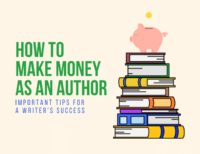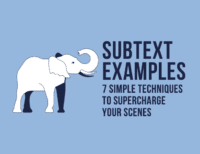What keeps you reading, turning page after page of a book, unable to put it down? A skillful writer has hooked you, capturing your interest. And if you want to create the same experience for your readers, you need to learn how to write a hook.

What readers want
What do readers demand from the stories they read? They expect to be entertained, to learn something, to be intellectually challenged, charmed, or tickled. Readers want to have questions raised and answered and they love action, chases, and puzzles.
But above all, readers read to feel something, to be stirred emotionally.
That’s why learning to craft an emotion-baited hook can be one of the most powerful tools in your toolbox. So let’s take a look at how to do that.
Light the spark
While it’s great to learn and develop the skill of pulling the reader inside your character’s viewpoint, allowing them to sense and undergo story events along with the character, the real goal is to open the door to a personal emotional experience for your reader. It’s almost magic how the emotion can leap like a spark from your character to your reader, firing the synapses that lead to an emotional response.
Through word choice, placement, and other techniques, we can set the stage for this to happen. As always, it’s vital to keep your target reader in mind, customizing to their preferences, and remembering that hooks are not intended to spur the reader long-term—just far enough to get them to the next hook.
Using hooks in combination is smart, too, as different hooks work more effectively for some readers than others. Install a backup or two.
What constitutes an Emotion hook?
In the article on Danger hooks, I talked about how action is not necessarily danger—it has to go farther than that. In the article on Surprise hooks, I talked about how the questions raised can’t be ordinary questions—it has to go farther than that. And now, I’m telling you that the emotions used in an Emotion hook are not standard level emotions—it has to go farther than that.
In a story, you want your reader to experience varying degrees of emotion rather than being in high gear the whole way through. But when it comes to setting the hook, put the emotion on steroids. And never forget context and reader expectations—those factors can change everything.
For instance, let’s say Gilda enters a singing competition and loses to a woman named Brandy. Gilda would be upset about that—an emotion, but not necessarily an overpowering one.
But what if Gilda knew that Brandy was having an affair with her husband? Now the singing prize isn’t the only competition Gilda is losing to Brandy. The emotion triggered by that realization could be devastating and would certainly qualify for the hook.
Let’s look at some examples
“She swung the frying pan around with all of her might. She caught him on the side of his skull, and the pan seemed to reverberate in her hands. He was still there, still standing, just staring at her. And then…He reached out. She screamed as his hands fell upon her shoulders.”
The Face in The Window, Heather Graham
This comes at the end of a home invasion scene, and you can imagine the homeowner’s overwhelming terror as the predator withstood her defense and kept coming for her.
“Lolita, light of my life, fire of my loins. My sin, my soul.”
Lolita, Vladimir Nabokov
Clearly, this is no casual emotion, but a soul-burning obsession that goes over the top.
“Once upon a time, in a far-off land, I was kidnapped by a gang of fearless yet terrified young men with so much impossible hope beating inside their bodies it burned their very skin and strengthened their will right through their bones.”
An Untamed State, Roxane Gay
This is the story opening, and reveals a glimpse of fiery determination that prompts the reader to remember a time when they felt that degree of motivation.
How to craft an Emotion hook
If you didn’t think to thread hooks throughout your manuscript, don’t despair! Catch it in the revision process.
Let’s watch that in action. Pretend this is the first draft of a short story mystery and I started it like this:
I once helped murder an innocent girl, and it wasn’t the first time I’d done such a thing.
Okay, that might get a reader’s attention, but does it contain emotion? Not such that you’d notice. Let’s go to the second draft.
On summer days, I remember how I helped murder an innocent girl and fulfil a gypsy’s curse. I feel terrible about it, especially because hers was not the first death I was responsible for.
So, now we’re getting a little more setting and flavor and we know he feels awful about what he’s done. But is it overpowering emotion? Not yet. Here’s the published version:
“When the breeze whistles through green leaves at a certain pitch or the crumbling smell of damp earth permeates the air, I remember the day I helped murder an innocent girl. Days like that, my part in fulfilling a gypsy’s curse and perpetuating a legend of blood and violence sits on me like a heavy sweat. The hell of it is, I don’t even count hers as the first death on my score sheet, but I’d roll naked through a bed of razor-fisted Dungeness to make sure it’s the last.”
A Touch of Native Color, Joslyn Chase
Now we’ve got character voice, sensory detail, and fervent, tortured emotion. This hook will carry readers at least into the next paragraph where they’ll encounter more hooks.
Some final thoughts about writing hooks
We've reached the end of this four-part series on hooks. I'll leave you with these last notes:
- Train yourself to think in terms of hooks when you’re writing, but don’t sweat it if you miss an opportunity. Revision is a great time to employ hooks in your stories.
- Learn more about hooks and be aware of the different types that are available for your use. Mary Buckham has written some good books on the subject of writing active hooks.
- Use hooks in combination and thread new ones in as you go along.
- Always keep reader and genre expectations in mind when crafting hooks.
- Placement is as important as the hook itself. Create your hook as a standalone, or let it start or end the paragraph or scene. Don’t bury it.
If you missed the first articles in this series, check out question hooks, danger hooks, and surprise hooks. Now that you know the power of hooks and you have the tools to craft several varieties, go out and reel in some new readers!
How about you? What’s your favorite type of hook? Do you notice yourself getting “caught” by hooks in your reading? Tell us about it in the comments.
PRACTICE
Once again, let’s practice developing a standard sentence into a compelling hook. Remember, the emotion involved in an emotion hook is extreme, so think in terms of overpowering emotion. Use one or more of the prompts below and craft an emotion hook as I did with my short story opening.
My mother called last night.
The envelope on Harry’s desk contained a pink slip.
Trudy ran a bubble bath and sank down among the lather.
Or use your own work in progress and craft an emotion hook from the opening paragraph or the close of a scene or chapter.
Write for fifteen minutes, and when you’re finished, post your work in the comments section. Be sure to provide feedback for your fellow writers!







0 Comments